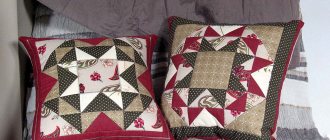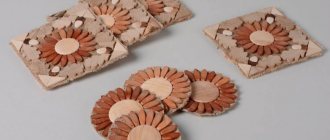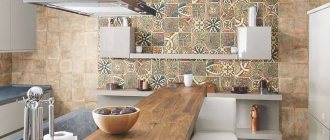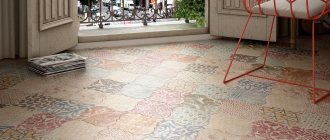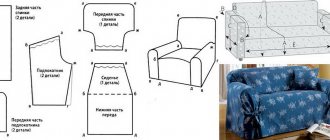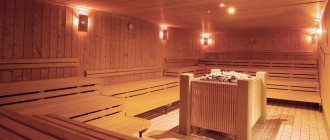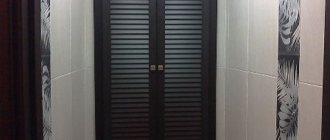What is patchwork technique?
Patchwork is a type of needlework that is a patchwork: pieces of fabric of different sizes and colors are sewn together in the form of a mosaic, and the result is an original and bright design.
- Patchwork has gained particular popularity only in the last few years, but this type of needlework cannot be called new, because it dates back to ancient times.
- People made bedspreads, pillowcases, sheets, tablecloths and even clothes for themselves from expensive scraps.
- In England and the USA, this type of needlework was called textile mosaic, which was classified as decorative and applied art.
- The patchwork masters left us as a legacy an excellent technique for creativity. We can use it to decorate our homes and sew soft original blankets for our children.
How to work with this technique? Anyone who is interested in her needs to clearly understand that she loves neatness and precision, although “patchwork” does not require special labor or skills. There are only a few basic rules that should be followed when creating products using the patchwork technique:
- It is necessary to think over a sketch of the future product. To sew the patches correctly, you need to at least imagine the end result in your head - what the final pattern should be on the blanket or sheet that we are sewing.
- Choose the fabric that suits you. Handicraft masters recommend using:
- Linen, which is very easy to cut and sew
- Wool, which makes excellent covers and bedspreads (this fabric can be combined with any semi-synthetic textile)
- Silk, from which you can make a very beautiful bedspread
- Sintepon, which is used as the insulating part of the blanket
- Fabric blanks must first be folded according to a template into a general pattern, and only then sewn together using a sewing needle, thread or sewing machine (this device will significantly speed up the process of creating a blanket or any other product that you want to make). As a rule, blanks are made according to three main schemes:
- When the entire canvas consists of different flaps
- When a pattern stripe is created in scraps on a single piece of any fabric
- When the product is a kind of applique that is made without glue using fabrics and a needle and thread
- Each piece of fabric used to create any product using the patchwork technique must be ironed so that the result is a perfectly smooth fabric without flaws.
- All flaps must have a clear sequence - they need to be measured with graph paper, contours created with chalk, cut very evenly and leave allowances for creating seams.
Modern patchwork has many varieties:
- Traditional - when pieces of fabric are sewn together in strict sequence;
- “Crazy patch” - when patches of different sizes can be sewn together as desired and at the same time decorated with beads, rhinestones, and buttons;
- Knitted - no different in technique from the traditional one, except that the flaps in this patchwork should not be sewn, but crocheted;
- Japanese - products are sewn only from silk and stitches. The main pattern of any product is geometric shapes;
- Quilting is when two sheets of any fabric, between which there is a warm lining, are sewn together with a machine stitch (quilted fabric). This technique is best suited for creating quilts and furniture decor;
Each piece of fabric can be prepared using a special technique. Your choice should be based on where you want your patchwork piece to be used. Let's name the most widely used techniques:
- “Squares” - 4 fabrics are taken and cut into strips of the same size. You need to arrange two strips and sew them together. Then these strips need to be cut into squares, which can only be sewn together into a single piece.
- “Watercolor” - you need to choose a fabric in 7 different shades (some of the fabrics may even have a light print), which will harmonize well with each other. From the squares of this fabric you need to fold a pattern.
- “Strips” - this technique of sewing fabric is similar to the principle of folding parquet. The main thing is that all stripes are the same length and width (this will be more beautiful).
- “Log cabin” - the basis of the future canvas is a large square of fabric with a pattern, which is trimmed in any shape with other scraps.
- “Triangles” is exactly the same principle in stitching technique as “Squares”, only the blanks are made in a triangular shape.
- “Corners” is a technique that combines elements of the “Squares” and “Triangles” techniques. First, squares are cut out and folded diagonally into isosceles triangles. They are stitched together in any shape, forming a three-dimensional fabric.
- "Chess" - when the squares are stitched together like diamonds in a checkerboard pattern.
- “Russian square” - squares, triangles and strips are sewn together so that the base is a square, from the corner of which rays emanate from triangles located base down, and the sides are trimmed with rectangular pieces of fabric.
- “Honeycomb” - scraps of fabric are cut into hexagons that need to be sewn together.
- “Lyapochika” - you need to twist any strips of raw fabric into tubes (here you can even use old T-shirts), which are sewn together in any shape.
Using any of the above techniques and varieties of patchwork, you can sew a baby blanket with your own hands from padding polyester and any other natural fabric. We will present you several detailed master classes in the following sections.
This is interesting: Pattern Beautiful baby blanket made from scraps
We sew a hut block - a well using the patchwork technique
Patchwork using the well technique is considered one of the simplest. Its basis is a square, which is covered with strips of fabric. In the classic version, if the central square is red, then the block is called a “hut”, if it is blue, then the block is called a “well”. But you can make it in any other color, depending on what kind of product you want to sew using this technique.
Choose the colors of fabrics for stripes to your liking. All the strips with which you will cover the square are the same width. The length of the strips must be measured each time before sewing the parts together.
The following describes in detail the patchwork technique for beginners step by step, following which you will sew a finished block:
- Cut out a 6x6 cm template from cardboard. Using it, cut out a square from fabric, leaving seam allowances of 0.5-0.6 cm (which corresponds to the width from the needle to the edge of the foot when sewing).
- Using the template, cut out a rectangle, but from beige fabric, and stitch it to the left to the red square. Align the edges if necessary and measure the long side of the resulting rectangle.
- Cut a 10 x 6 cm rectangle from the fabric of the following color and sew it on as shown in the photo. Press all seams carefully.
- If you follow the patchwork technique, you will get a rectangle 10 x 12 cm.
- Along the right edge of the block, attach a strip 6 cm wide and equal to the right side of the resulting fragment (10 cm), made of fabric of the fourth color. Pin it perpendicular to the seam and stitch. Then carefully press the seam.
- Take the next strip of fabric of a different color, also 6 cm wide (5th color in our block), attach it to the bottom edge, cut it, pin it.
- Stitch, remove the pins and press the seam to one side. Smooth out all edges with a rotary cutter or scissors.
- Proceed to the second round. Attach a strip of beige fabric 6 cm wide to the left side of the square, pin it, stitch and iron it. This is the 6th color in our block.
- Similarly, sew a 6 cm wide strip of a different shade of beige to the top of the block.
- You can stop at this option, or you can continue sewing strips clockwise until you are satisfied with the size of the block. For example, if you want to sew a pillow 40 x 40 cm, then you need to continue sewing strips to the desired size.
- Strips of fabric of the same color should not be next to each other. Please note that on the right side of the block I have pink fabrics, and on the left - beige. You can make a block in different ways, for example, place dark stripes of different colors on the right, and light stripes on the left (about the same as shown in the photo).
- Finish the block with a red stripe 6 cm wide. In total, you get 3 circles of stripes that do not touch each other anywhere in the pattern.
Important! The hut block in patchwork is performed strictly in a spiral. If you start sewing clockwise, then continue until the end of the block. If counterclockwise, then the same thing. In this case, the block is sewn clockwise.
Patchwork seams are usually ironed on one darker side, so I ironed on the red side.
Working step by step using the patchwork technique, you will get a finished block.
The well can be sewn from strips of different widths, using fabric of different colors, it all depends on your imagination and desire.
Variety of styles
Chaotic patchwork also has its own directions. Not all of them are ideal for creating blankets using this technique. Styles are:
- classical. The most suitable for sewing a blanket, as it easily fits into the selected dimensions and monotonous decor of the room. This style includes patches of equal size, often in two color schemes, which are placed in clear symmetry or in a checkerboard pattern;
- Oriental. More suitable for decorative small blanket. The style is maintained in the use of flaps of different shapes and sizes, adding to them a variety of embroidery with threads, beads, beads, as well as zippers, buttons, chains and any other type of decorative design. However, unlike the next type, the eastern one adheres to a certain system and symmetry in stitching the flaps;
- crazy patchwork is a “crazy” patchwork technique. The style, which is not limited in the shapes and placement of flaps, combines the chaotic clumsiness of the placement of parts and a mixture of color schemes. More suitable for blankets and bedspreads of outdoor garden decor.
Quilt patches come in many forms:
- squares - simple stitching of square flaps of the same size;
- stripes - flaps of stripes can be sewn either alternating or in a circle, into a spiral, decreasing their length as you work, using a template in the form of a lined square;
- triangles - in order to achieve a smooth square canvas at the end, such flaps are cut in the form of isosceles triangles;
- honeycombs - symmetrical hexagons, which are combined with triangular flaps along the edge;
- lapachikha is a type of patchwork made from patches of different shapes, assembled into a specific pattern according to a pre-prepared template.
Fabric selection
Before you move on to creating a product using the patchwork technique, you need to choose the right fabrics for future work.
First of all, it is worth noting that there are no strict requirements for the composition of fabrics for patchwork. However, craftswomen should give preference to cotton, teak or chintz. Such fabrics hold their shape well, so they will not deform during operation. In addition, for products created using the patchwork technique, you can use old jeans, shirts and other things. Quite often, jeans are used to create blankets. In addition, thick fabrics are well suited for blankets and bedspreads.
Making a Patchwork Quilt
Making a blanket using the patchwork technique differs from other types of sewing blankets only by working on the front part. For a blanket in a classic patchwork style you will need:
- scraps of fabric measuring 25x25 cm, 20 pieces;
- filler 130×130 cm;
- fabric for the back 130×130 cm;
- fabric for the canvas seal 130×130 cm;
- sewing machine, needle and thread, scissors.
The first step is to lay out the flaps in the required order.
The second stage involves connecting the flaps together into strips.
The third step will be to connect the strips into one canvas.
The fabric should be ironed well, after which the appropriate part should be cut out of the seal according to its size.
After this, you should cut out a piece of the appropriate size from the backing fabric or filler. We lay out the parts in the following order: seal, filler, canvas, wrong side to the filler, wrong side, right side to the canvas.
Please note that, if desired, the filling can be inserted into an already sewn blanket after turning it inside out.
All parts need to be sewn together, leaving a 10-15 cm hole for turning inside out.
Having removed the protruding corners and uneven edges, turn the blanket inside out and sew up the hole.
The blanket is ready. According to the described size, it is more suitable for a child, but the size of the fabrics and the number of flaps can always be changed to suit your own preferences.
To create a more complex blanket pattern, you can use the following patterns:
Patchwork: patterns, templates
You can create diagrams and templates yourself or take ready-made patterns from the Internet, books or magazines. Templates are cut along the contour of the part, taking into account seam allowances. The material for production can be cardboard, thick paper, plastic. For accuracy, you can stick graph paper on the cardboard, and then cut out the shape of the intended size. When making curved blanks, longitudinal cuts-notches must be made on the outer contour of the template - it is convenient to mark seams along them when connecting the flaps.
Photo and video tutorials on patchwork sewing offer diagrams, templates and MK
Cutting rules
The most convenient templates are frames. The inner part must correspond to the finished size of the fragment, the outer part takes into account seam allowances. The width of such a frame is the size of the allowances. When making a pattern, the frame must be circled twice and cut only along the outer contour. The inner outline will show the seam line. The pattern is transferred to the fabric with chalk or soap; any pen leaves marks on the front side. Cutting is done only along the grain thread, so that subsequently the sewn parts do not stretch or warp. Cut out the flaps with regular scissors or a special cutter. A roller cutter makes the process much easier, cutting long strips that are easy to cut into smaller pieces. You can't do without a cutter when the templates are curved.
Related article: How to install rafters?
Pattern selection
There are 3 types of products in patchwork technique :
- A fabric sewn from shreds the parts are assembled seam into seam. The shape of the patches can be regular, geometric (traditional sewing) or arbitrary (crazy patchwork). Watch video lessons.
- Quilted items are made from a whole piece of fabric, the pattern on which is created using stitches.
- Applique – pieces of other fabrics are beautifully placed on the base, sewn and quilted.
“Frame” is the simplest and most convenient template for cutting
Fabric for making a patchwork blanket
Patchwork is patchwork sewing from fabric of various household and decorative items - beds, blankets, bags, clothes, tablecloths, kitchen utensils, etc. The technique, known for thousands of years, is popular all over the world. Skilled craftswomen create all sorts of outlandish works of art using the patchwork method. And novice needlewomen are advised to start with wide blankets made from “quick squares”. Such products are practical and aesthetic, and are also optimally suited for mastering such a delicate science.
Today, patchwork is considered one of the most popular patchwork techniques. It consists of stitching together various pieces of fabric according to the mosaic principle. In the hands of experienced needlewomen, bright pieces of material are transformed into luxurious products that surprise and delight. But not all fabrics are equally good for patchwork patchwork.
To choose the right material for creating a patchwork quilt, you can follow the traditions of our grandmothers: simply save all the scraps and leftovers from sewing clothes or bed linen. From such different-sized shreds you will certainly get a motley blanket. Or you can do it much simpler - purchase a set of fabrics for patchwork at any specialized store. Since the most difficult process in the patchwork technique is working with the material, the fabric must certainly not only be beautiful in appearance, but also of sufficient quality.
Cotton fabrics are considered the ideal material for patchwork because they meet all the important requirements:
- Do not wrinkle;
- Don't rush;
- Do not shrink;
- They do not shed;
- Easy to cut.
Linen, silk, viscose and wool are used a little less often in patchwork, since such materials are more capricious and always require special care in work. Craftswomen with experience begin to use complex fabrics; for beginners, there is nothing better than cotton!
Sewing material stores offer customers a huge selection of cotton fabrics of different colors and densities. But, unfortunately, they are not always suitable for patchwork. Some options fray too much when cut, others are hard to iron or sag after washing. It is, however, recommended to buy special fabrics for patchwork that have undergone special pre-treatment. This material is very easy for beginners to work with.
Where to begin
Undoubtedly, starting something new, completely unusual is always a little scary. A few useful tips will help beginners in patchwork sewing overcome this threshold, get involved in the work and truly enjoy it.
- Choose a suitable fabric that is easy to work with. Beginners should not learn from fabrics that are expensive, complex in texture and weave. The most beautiful things are made from chintz or any other cotton fabric. And it will be comfortable to work with, since such shreds practically do not fray and do not stretch in different directions, the seams are smooth, and the joints are precise. A patchwork made of denim looks great and stylish, but it should be taken into account that denim is a dense material, not every machine will accept a combination of several such patches.
- You can ignore the color scheme of the patches at first; later you will learn to select harmonious combinations for different schemes.
- Before work, prepare the selected fabric: wash it and iron it. This way you will prevent shrinkage and deformation of the finished product later.
- You should have the necessary tools at hand: scissors, threads, needles, tailor's pins, a sewing machine, tailor's chalk or cutting scraps, patterns for patchwork products, synthetic padding, a tailor's ruler or a measuring tape. Over time, if patchwork really excites you, you can purchase a special cutting knife: a rotating blade allows you to simultaneously cut several layers of fabric.
A lot depends on the choice of fabric, so be careful at this stage: let the time spent on work not be in vain. Watch the following video, which explains the basic principles of choosing fabrics for patchwork:
Do not immediately take on complex patterns and large products; look for designs with detailed instructions, for example, for a patchwork pillow. A master class on creating geometric or square appliques will explain to you the basics of patchwork, after mastering which you can move on to the next, more complex level. Working with irregularly shaped elements (with curves, sharp corners, fancy joints) requires certain skills.
Panel made from patches
Popular types and patterns of patchwork
The patchwork style is a wide field for ideas and experiments, which has no boundaries in combinations of shapes, colors, and types of material. Here, any creative idea of the author can be brought to life. Fancy patterns, applications with animals and flowers, geometric mosaics and other equally interesting options can easily be folded into a warm bedspread or comfortable blanket.
Of course, you can create a diagram for a product with your own hands, armed with imagination and a sharp pencil. Or you can use ready-made ones, of which there are hundreds of thousands, depending on the types of patchwork.
Let's look at the most popular types of patchwork:
- Classic English
. In this version of patchwork, all parts of the same shape and size are used, usually in two primary colors. Patterns for English patchwork are very primitive. For example, squares of two shades arranged in a checkerboard pattern, or symmetrically stitched triangles. - Eastern patchwork
. The manufacturing principle is similar to the classic one, but differs in the use of various decorative elements - ribbons, beads, zippers, etc. Most patterns for oriental patchwork products allow greater freedom in the shapes and sizes of parts. For example, these can be arched and wavy patches, connected and decorated with satin ribbons. - Crazy patchwork
. The most “free” look. Characterized by its aesthetics and attractiveness. As a rule, the shape, color and size of parts are not limited by anything other than the pattern used. And the designs can be incredibly diverse: images of nature or flowers, floral or geometric patterns, complete abstraction.
This is interesting: Pattern Cool children's hoodie
Patchwork - diagrams, templates and patterns for beginners
You should consider patchworking beautiful things and easy step-by-step instructions for beginners. You can make a wonderful pot holder or blanket.
The blanket is very easy to make. First, choose a technique that you like.
A fabric of the required dimensions is created, then the second side is sewn from the inside out. Do not sew the top, fill it with blanket composition, which must be purchased in advance.
It depends on what you want to fill the blanket with. All that's left to do is stitch it up.
Nice and simple. And a hand-made blanket will warm you twice as much.
DIY blanket
The rug is best made using one of the circle-based techniques. The rug needs a thick base. An ornament of the required size is created. The edges are processed and sewn with stripes of a different color. All that remains is to attach it to the base using glue. The rug is ready.
You will have to tinker with the potholder. Using the chosen technique, two bases are created, a lining is sewn on so that the product does not rub against the skin. Now, cut-to-size potholders are connected to the wrong side. Turn it inside out and it's done.
Attention! Dense material is suitable for tack. A tack made from lightweight material will be of no use.
The article covers a large number of techniques, but that's not all. There is plenty of room to roam around, so you should choose what you like and create for your health! The incredible variety of techniques, the ability to create stunning patterns and designs make you look at patchwork in a new way, giving new life to old things.
And after practice, you can buy fabric and delight your loved ones with new gifts or attributes for everyday use.
New-fangled trends have brought back to life the production of products from scraps of fabric, returning patchwork to its former popularity. Patchwork will be useful to everyone who wants to decorate their home in an original way, have exclusive clothes and accessories, or please their loved ones with a cozy gift.
At the very beginning of the journey into the wonderful world of patchwork, it is extremely important for beginning needlewomen to remember a few rules that will make learning easy and enjoyable.
Peculiarities
Patchwork is an ancient skill that can be traced back to the invention of fabrics themselves. The thrifty housewife did not throw away precious scraps of material, but sewed them into linens for further use. Museums around the world have historical exhibits that confirm the interest of our ancestors in quilting. A carpet made from fragments of pilgrims’ clothes was discovered in the Cave of a Thousand Buddhas; it dates back to the 10th century. One of the museums in Egypt displays a canvas made from pieces of leather, the appearance of which dates back to 980 BC.
The peculiarity of patchwork art lies in its uniqueness . It is impossible to make two identical blankets from the many scraps, so each product is exclusive. There are other advantages of the patchwork technique:
- Only threads are used to create the product, and the canvas itself is assembled from scraps;
- by piecing together scraps, you can sew blankets of different sizes, even for non-standard children's beds;
- during work, any fantasies are realized, and the more original they are, the more the craftswoman will be able to surprise with the final result.
The colorful pattern of the paintings adds mood, it brings comfort to any home. A patchwork-style blanket can be supported by a mosaic pattern on the wall, a bedside rug made from pieces of fabric, or an equally colorful lampshade. The main thing is not to overdo it, otherwise the original interior will turn into a tacky and tasteless environment.
To prevent the blanket from looking haphazard, craftswomen put a certain logic into the selection of patterns and colors . For example, the entire ornament is built around a central plot appliqué, or patches are selected that match the dominant shade of the children's room. The pattern of the blanket should not put pressure on the eyesight or create an imbalance in the interior, so designers recommend choosing several primary colors and 2-3 background shades to create it. Variegation and many small details are allowed in small children's rooms.
A blanket for a large room is formed from large patches connected by a common storyline or making up a common ornament.
Blanket Making Tips for Beginners
Nowadays, patchwork creations have become more popular than ever. In between the noisy bustle and tiring workdays, you really want to touch something warm and cozy. Even those women who have never thought about needlework before begin to confidently master patchwork. Decorative sofa pillows, aprons, coasters, colorful panels, curtains for a country house, ultra-modern bags and many other things can be created by experienced craftswomen.
Beginning needlewomen should pay attention to a few useful tips:
- Before using new fabric, it must be washed, ironed and only then cut. This will prevent accidental shrinkage, loss of color, or other problems.
- The color of the thread used should match the color of the shred or differ by a couple of tones.
- For drawing, use a pencil or soap. It is prohibited to use a pen.
- Cutting is done along the shared thread. In this case, the part will not warp.
- When cutting, leave a 1 cm indent on all sides. If the fabric is loose - 1.5 cm.
- Ideal templates are made of plastic.
- Without a ruler, patchwork is impossible.
- The resulting fragment must be ironed after each line.
Patterns for making a blanket using the patchwork technique
Depending on the chosen patchwork technique, the needlewoman may need one or another pattern pattern:
- Square technique
. It involves creating a product from square patches or square blocks of different colors. In this case, a pattern in the form of a regular square or a pattern of strips from which a square block will be made will be useful. - Strip technique
. This is parallel or circular stitching of strips of different colors and lengths. To create a product using this technique, you will need to cut out different strips. - Triangle technique
. In many ways similar to squares. Most often, patterns of isosceles triangles, identical in size, but different in color, are used for it. Parts can be sewn along a short edge to form a strip, 4 pieces to form a square or in the shape of a star. - Honeycomb technique
. It got its name thanks to the end result. Upon completion of the work, the design of the product will resemble the pattern of a honeycomb. For production, patterns of symmetrical hexagons are used. - Lapachikha technique
. It is considered the most interesting and at the same time difficult. Pieces of fabric with raw edges are attached to the canvas, thereby forming a three-dimensional drawing of a certain pattern or a chaotic image of a three-dimensional abstraction. If a specific pattern is chosen for the product (bird, animal, flower, etc.), patterns for each part will be needed. If you plan to randomly sew on different patches, you can do without patterns altogether.
How to make a patchwork blanket - watch the video:
Products made using the patchwork technique are not only beautiful and cozy home decorations, but also positive emotions from the process of making them. Agree, a few pieces of fabric, a sewing machine and imagination in combination can work wonders.
Pattern and sewing
The following sequence of actions will allow you to avoid common mistakes when working with patchwork technique.
- In accordance with the existing diagram, prepare cardboard patterns.
- Cut out the parts necessary for the product using patterns.
- Connect the parts, fasten them with tailor's pins, machine sew them with a stitched seam, and press the seams (depending on the connection pattern). The more accurately and carefully you complete this stage, the more beautiful and neat the final product will be without distortions.
Making a blanket using the patchwork technique is a painstaking process, especially if the patches are chosen to be small in size and some interesting pattern is planned. Go to such large-scale products if you have already gained some experience with potholders, pillows, and small rugs, otherwise the result may disappoint you.
Patchwork duvet and pillows
In the following video, we suggest getting acquainted with simple ways to connect squares into a “half-square triangle” block :
What are they?
Patchwork blankets for children are especially varied . They are rich in color, contain applications, thematic images based on the plots of your favorite cartoons. In addition, products can be for a boy or a girl, intended for a newborn baby, or sewn in certain sizes, especially for a baby’s crib. Children of any age – from toddlers to teenagers – can appreciate these funny blankets.
We invite you to look at a selection of children's blankets to understand how beautiful, original they are, and made with great love for little users.
- When creating a blanket for boys, they often resort to a marine theme. Here you can use white and all shades of blue. The younger the child, the weaker the tonality and the more delicate blue is present in the product. Marine themes with other shades are used much less frequently; they are used when it is necessary to maintain the overall color of the interior.
- Kids especially like blankets with a large pattern in the center ; it can be viewed as a picture, including imagination and inventing adventures for their favorite characters.
- Look how lovingly you can completely decorate a baby’s crib in patchwork style. The sheet, blanket, pillow and even the sides are made of bright patches. A variety of funny bunnies will hold the baby’s gaze for a long time, because they are not repeated, but you want to look at each one.
- For the little princess choose light and delicate colors . A large number of pillows made from pieces of fabric, bows and lace sit on top of a quilt with appliqués.
- Boys prefer products with pictures of cars . For a baby, a calm background is selected, and an older child can be offered a riot of colors. The colorful canvas with pictures is impressive and delights children.
- Stories are also being developed for animal lovers. For example, a teenager can be offered a beautiful canvas depicting African wild animals (safari). And for a little one, a plot with mischievous dogs, or kind pets that he saw in the village with his grandmother (farm theme) is more suitable.
- Your teen will appreciate a blanket with photos of family memories . The canvas is sewn from squares containing non-repeating plots.
For kids, each square can become their favorite frame from a cartoon.
- When creating children's blankets, they often resort to appliqués ; they neutralize the diversity of the patches and interest children in a specific topic, as they often depict animals, favorite equipment, or cartoon characters.
- A complex blanket for a girl was made with extraordinary love, using many techniques. It does not contain a specific plot, but shows good taste and high skill of the author.
Overview of techniques
Over the millennia of its development, patchwork has developed different techniques for making canvases from pieces of fabric. There are so many of them that it is impossible to cover them all in one article. Let's look at the most popular of them.
From the stripes
This type is considered the simplest technique, since sewing identical strips together is easy even for a novice craftswoman. For the strip stitching technique, the material is prepared in advance. They cut out identical elements in the form of elongated rectangles from pieces of fabrics of different colors and structures, and then sew them together. You can place a large square with appliqués in the center of such a blanket.
From squares
Blankets made from squares are just as easy to create as from stripes. This technique is one of the most ancient . But this applies to flaps of the same size. If the product uses squares of different sizes, you will need a diagram with which to lay out the working material. The pattern is chosen by the craftswoman according to her taste: it can resemble a chessboard, alternate colors in rows, or look chaotic.
The squares are sewn side by side to each other, or a more complex stepwise stitching design is chosen, when one flap begins to be sewn from the middle of the edge of the second. The pattern in this case resembles the laying of ceramic tiles. A similar stitching technique can be used to create a fabric of triangles or rectangles . In the first case, it is better to choose isosceles figures . High-class craftswomen, using geometric rags, are able to create “pixelated” portraits that look like photographs.
"Well"
The beautiful, unique “well” style is also called “American square” ; it was very popular in America several centuries ago. Europeans also made him famous by borrowing equipment from overseas. The basis of the product is a small square located in the center of the blanket, around which larger squares are gradually built up, sewn together in size in ascending order. If you look at the canvas from above, it creates the illusion of a well made of logs.
This technique gives visual volume and depth to the picture, especially if you use color effects correctly.
Watercolor
In this technique, it is the color, not the shape of the flaps, that is important. A watercolor blanket may consist of squares, stripes or shapeless segments, but they are all united by one color scheme, as if painted in watercolor and created with an artist’s brush.
From hexagons
The blanket is sewn from hexagons of the same size, cut from scraps . If you introduce shades of honey color into the canvas, it will begin to resemble a honeycomb. But most often a harmonious hexagon is used to create a flower or star blanket; other artistic images are created less often.
"Lyapochika"
The most beautiful and voluminous technique, used for many years in Russia . The “frog” blanket is made up of tiny scraps, the free end hanging from the canvas. Even more volume is provided by pieces of fabric rolled into a tube. Creating such a product is hard, painstaking work, as you have to work with a large number of small parts. Thanks to the selection of various shades, you can create paintings from scraps. They, like canvases painted with oil paints, look amazingly beautiful if you move away from them.
Patchwork: master class for beginners
Special comfort in the interior is created by handmade items, in particular, beautiful and comfortable pillows. Let's try to sew a decorative pillowcase with a voluminous "Rose" application using MK. You can take any scraps for work, the main thing is that they match well in color. Don't forget to prepare the fabric - wash it, iron it.
Master class “Pillow with applique”
Step-by-step instruction .
- It’s convenient to start by preparing squares. Their number and size determine the size of the pillow.
- Then you need to cut a circle out of the fabric. In the middle, put a piece of fabric and some filler for volume (cotton wool, padding polyester). Secure in a circle using a machine stitch. The middle is ready.
- Fold the squares from the flaps diagonally, as in the photo, sew around the middle piece in a circle - 3-5 pieces.
- For the next round you need to prepare large squares of the corresponding color. Continue until the end of the intended flower size.
- The sewn petals must be trimmed in a circle.
- The finished roses are beautifully distributed on a pillowcase and secured to the product with a zig-zag seam and a wide, dense stitch. The rosette has the appearance of a three-dimensional appliqué.
- If desired, the bouquet can be supplemented with leaves cut from scraps of a suitable color. Look at the photo for a step-by-step master class. The blanket in MK is made using the “crazy patchwork” technique (you can watch video tutorials), and it consists of 30x30 cm squares. For a single blanket you need 24 pieces, for a double blanket – 36. Let’s say the pattern will be made up of 4 types of fabric.
Related article: Decorating the interior: Autumn crafts made from straw (38 photos)
The complexity of the ornament depends on the experience and skills of patchwork sewing
Master class “Patchwork for beginners - blanket”
Tools and materials:
- 1 m of fabric of each color (width 220 cm) - 6 or 9 squares 45x45 cm;
- For the lining - 170 cm or 220 cm (the margin at the bottom goes away after the blanket is quilted);
- Sintepon of similar sizes;
A blanket or bedspread can be sewn from simple squares or complex pieces
Step-by-step instructions for MK:
- Cut into squares and stack, alternating colors.
- Cut this layer cake diagonally or randomly. It is convenient to cut with a roller knife.
- Take the part from above and move it down under a stack of similar elements. In a cut stack there will be 1 piece of the 1st color on top and 1 piece of the 2nd color.
- Machine sew all the squares along the cut line.
- On an ironing board, carefully press the seams to one side or press them flat.
- Fold the blanks into a neat stack in the same order - squares of the 1st and 2nd tones on top.
- Using a ruler and a knife, cut the entire stack again along any line (you can cross the first seam).
- Move one of the top fragments down under the stack. Sew and press, remembering to fold in order - now it’s better to match the seams.
- The operation is repeated until the last detail. The optimal number of seams is 6-10 horizontally and vertically.
- After ironing the seams, you need to trim the squares to get a figure with a side of 32 cm.
- You can assemble the blanket in different ways: first assemble the front part, then quilt it with padding polyester and lining. It's difficult on a typewriter. Or quilt each square separately, cutting padding and lining.
- Gather the quilted squares together, trim and cover the seams with narrow tape or strips of fabric. It is convenient to assemble according to the scheme: ribbons of 4-6 squares, then sew the strips.
- Along the edge of the blanket, you also need to trim it with an edging made of plain fabric or pieces of rags, as in the MK photo.
Congratulations on your new look!
Materials
For the patchwork style there are no restrictions in the selection of material, the main thing is harmony in the combination of texture and color . As for children's blankets, there are certain recommendations for the use of fabrics. For small users, natural products are predominantly chosen, soft, tactilely pleasant, with environmentally friendly dyes, ensuring complete safety for children. The following fabrics can be used to decorate children's bedrooms.
- Cotton . Durable and natural material, it makes durable and beautiful blankets. Many types of fabrics are produced from cotton.
- Flannel . Soft, pleasant to the touch fabric made from cotton threads. Often used in products for newborns.
- Linen . Dense, rough material with a high degree of hygroscopicity. Suitable for summer blankets in country and ethno style.
- Kulirka . The thinnest and smoothest cotton jersey, the touch of which children really like.
- Silk . Natural silk is beautiful, but very expensive, even scraps are rarely found. Its sliding texture is not to everyone's taste. But silk is ideal for oriental styles. The same characteristics apply to satin products.
- Fleece . The fabric is synthetic, but soft and light, pleasant to the touch, and does not require complex care. The bottom layer of the blanket can be made from natural material, and the top layer from fleece patches.
- Chintz . Durable cotton fabric in a variety of, mostly bright colors. The bedspreads are inexpensive and elegant.
In addition to fabrics, knitted fabric made in the form of colorful fragments is used to create children's blankets in the patchwork style.
Patchworking for Beginners
Napkin made from scraps
To create a patchwork napkin, you will need 7 rectangular strips of fabric. These stripes can be any color. It is recommended to think in advance about the order in which they will be placed on the finished product.
Take two strips and place them on top of each other so that the front side faces inward and the back side faces outward. Having made a small indentation from the edge (0.5 cm), sew these two strips on a sewing machine or by hand. Once you have joined the two pieces, unfold the resulting rectangle and press the seam. Sew the remaining pieces in the same way.
Fold the resulting fabric in half with the wrong side up and, stepping back 0.5 cm from the edge, sew the product on both sides. Then, after cutting the corners, turn the work inside out and straighten the corners. Iron the resulting product. Fold the fabric inward from the unstitched side and machine stitch it so that there is a pocket on top for cutlery.
Making a pillow
A do-it-yourself pillow made from scraps will be an excellent decoration for any interior.
First, decide on the size of the future product. The number of squares that will need to be prepared to create a pillowcase will depend on this. Having decided on the dimensions of the future product, as well as the work pattern, you can begin cutting out the patches. If desired, you can sew appliqués onto the squares. However, this must be done immediately before assembling the product.
Dimensions
Baby blanket sizes vary. The patchwork technique allows you to make products of any parameters, from envelopes for newborns to teenage bedspreads for a single or single bed. To ensure that the blanket matches the size of the rest of the bedding, there are still certain standards.
- Single products - 110x140 cm. For the little ones, square options are made 110x110, 120x120, 130x130 cm.
- One-and-a-half blankets – 135x200 cm or 140x210 cm.
As for European standards, another 10 or 15 cm should be added to the above parameters. Many craftswomen prefer to sew non-standard blankets that are comfortable for a particular child and designed for his sleeping place.
Patchwork equipment
Patchwork has become so widespread that in many handicraft stores you can see and purchase patchwork kit But for those who are not going to do such handicrafts all the time and do not want to spend money on purchasing such a set, tools that can be found at home for free are suitable.
Tools
To create a patchwork masterpiece you will need:
- scissors or roller cutter
- needles
- threads
- pencil
- pins
- centimeter
- chalk
- paper
- sewing machine (if there is a lot of sewing to do)
Textile
In addition, you need materials that can also be purchased at the store or searched for at home. To create a beautiful multi-colored craft, you will need colorful pieces of fabric and lining - all this can be cut from unusable old clothes, bed linen, scarves, curtains and other unused household items.
Patchwork tools
Properly selected tools greatly facilitate the process of creating a product. And patchwork was no exception. In this regard, it is necessary to take a responsible approach to the choice of tools for this type of needlework, as well as prepare everything you need in advance. To work using the patchwork technique, you will need:
- Chalk, soap or pencil.
- Graph paper.
- Scissors.
- Needles.
- Pincushion.
- Threads.
- Sewing machine.
- Ruler.
- Centimeter.
- Iron.
- Cardboard.
An iron is needed to iron the fabric before starting work. In addition, in the process of creating a product, it is necessary to iron segments, seams and blocks. Using a pencil or chalk, craftswomen transfer the pattern onto the fabric. For convenience, some are drawn on fabrics and seams. In order for the pattern to be made correctly, novice needlewomen are recommended to use graph paper.

